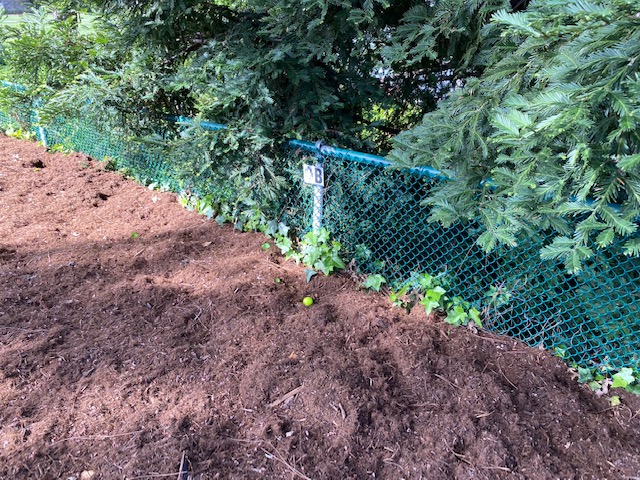by Joyce McCann – 18ers Rules Chair
The most difficult challenge for many of us about the par 3 fourth hole on the Dollar course is that alignment of the tee shot has to be angled to the left. Thus, it is very easy to slice the tee shot and end up behind the trees, in the rough on the right, or sometimes even OB. In this example, let’s say you do slice your tee shot. It escaped OB, but landed somewhere in the rough. While looking for your ball, you accidentally move it. Under the old rules, you would have to take a penalty stroke and replace the ball as near as possible to where it was, not more than 1-club length away and no nearer the hole. Under the new Rules, you do not have to take a penalty stroke (Rule 7.4), and you simply replace the ball in its original or estimated position (Rule 14.2c).
You skull your next shot over the green and it runs down the hill, coming to rest against the chain link fence. Unlike the protective fence on the 3rd hole by the 4th tee box, which is an immovable obstruction from which you can take free relief, the chain link fence is a boundary fence from which you cannot take free relief. Had your ball flown over the fence, it would be OB. But, your ball came to rest against the fence and thus was still in-bounds. A ball is only OB if ALL OF IT is OB.
So, what to do? If, after you hit your 2nd shot from the rough, you legitimately thought your 2nd shot might be OB or lost, you could have hit a provisional ball (announcing this first to your playing partners). However, after walking up, you find that the ball is neither OB nor lost, but is in an unplayable position next to the boundary fence. Since a provisional can only be used if the ball was actually OB or lost, you cannot then decide to play the provisional [Rule 18.3c(3) Interpretations] and it has to be abandoned.
From an unplayable position, you always have the option of going back and hitting the ball again, taking a stoke-and-distance penalty, which would mean walking all the way back to where you hit the provisional that didn’t count. However, you have two additional options, both involving a 1-stroke penalty. Unfortunately, in this situation it appears that neither of these will work. You can’t take “back-on-the line” relief straight back as far as you want on a line from the hole extending through the spot where your ball lies because that would mean you would have to climb the fence and hit the ball from OB, which is a no-no. That leaves you with the option of taking lateral relief.
As in all cases of taking relief under the new Rules, the first thing to do is to find the reference point. In the case of lateral relief from an unplayable ball, the reference point is where the ball lies, in this case next to the chain link fence. [Note that this reference point is different from the reference point when you took free relief from the protective fence on hole #3 – in that case the reference point was the nearest point of compete relief from the obstruction]. From the reference point you then would normally define a lateral relief area spanning 2-driver lengths from the reference point no nearer the hole. But, in this situation finding a relief area does not appear possible. Even if you can find a legal relief area, it would always include an unplayable position next to the fence. Since the hill near the fence is steep, the dropped ball would very likely roll back down next to the fence. Since that position is included in the relief area, the drop would have to be considered “good” – i.e., it counts. You would then have to declare the ball unplayable again (for an additional 1-stroke penalty).
This situation, which is not uncommon on hole #4, is particularly difficult. A ball that comes to rest against the chain link boundary fence is neither OB nor lost, but it is unplayable. Hence, even if you have hit a provisional ball, it must be abandoned [Rule 18.3c(3) Interpretations]. And, because the fence is a boundary fence, and because of the steep hillside adjacent to the fence, neither back-on-the-line relief nor lateral relief are reasonably possible. The only realistic option the player has is to take the stroke and distance option, walking all the way back to where the previous shot was hit, which may very well be the tee box, using up lots of time.
It is of interest that the new Rules of Golf include a Local Rule that could be adopted, which would be helpful. Model Local Rule E-1.3 (p465 Official Guide to the Rules of Golf) allows the designation of a drop area for unplayable balls when the only relief option is stroke and distance. But, as of now, this Local Rule has NOT been adopted by our club. Therefore, if you find yourself in this situation, you will have to walk all the way back to where you may have hit a provisional ball that didn’t count, and hit another shot.

